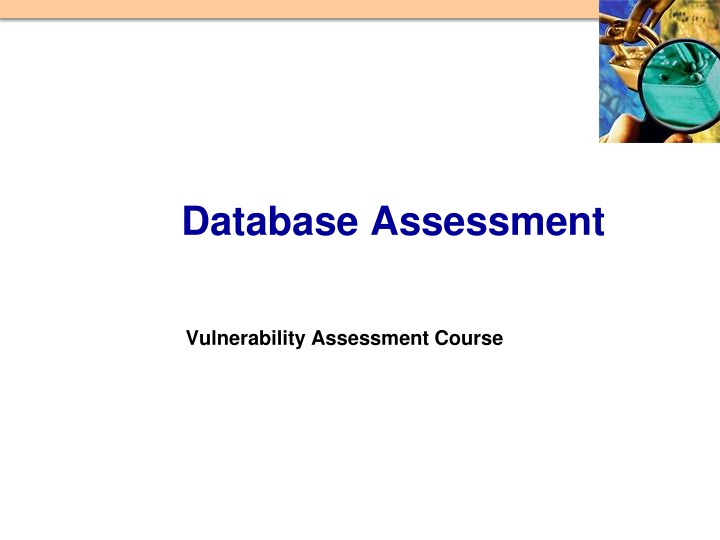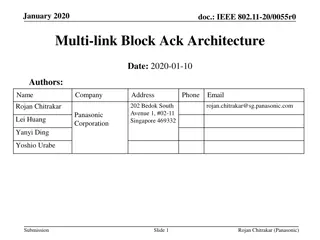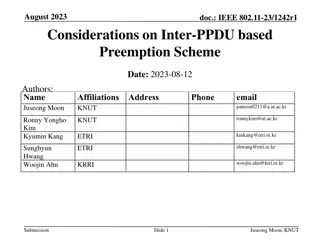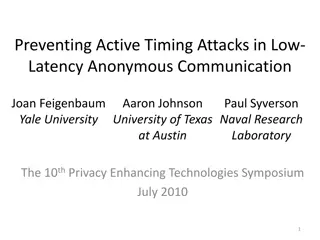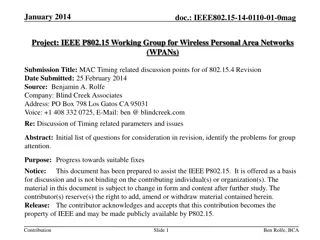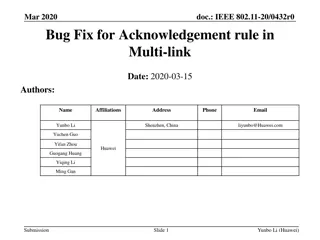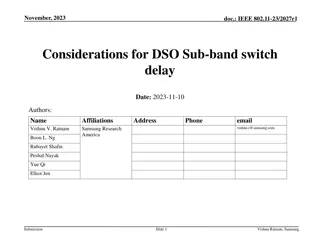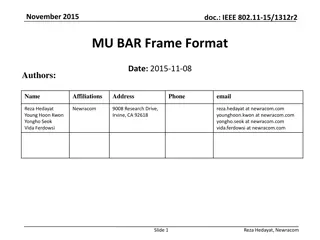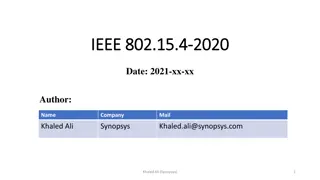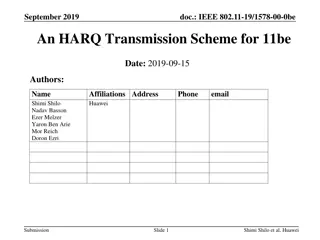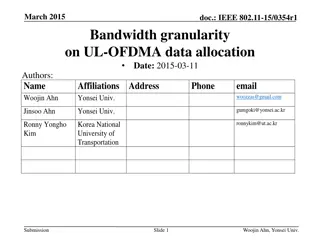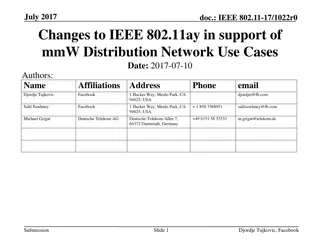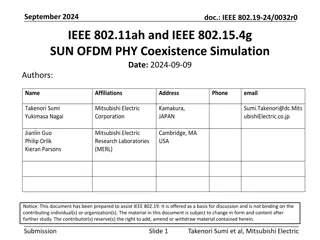Enhanced Ack Timing Issues in IEEE 802.15.4-2020 Standard
This document discusses the Enhanced Ack timing problem in the latest version of the IEEE 802.15.4 standard, highlighting the discrepancies and potential solutions identified by Khaled Ali from Synopsys.
Download Presentation

Please find below an Image/Link to download the presentation.
The content on the website is provided AS IS for your information and personal use only. It may not be sold, licensed, or shared on other websites without obtaining consent from the author.If you encounter any issues during the download, it is possible that the publisher has removed the file from their server.
You are allowed to download the files provided on this website for personal or commercial use, subject to the condition that they are used lawfully. All files are the property of their respective owners.
The content on the website is provided AS IS for your information and personal use only. It may not be sold, licensed, or shared on other websites without obtaining consent from the author.
E N D
Presentation Transcript
Database Assessment Vulnerability Assessment Course
All materials are licensed under a Creative Commons Share Alike license. http://creativecommons.org/licenses/by-sa/3.0/ 2
Agenda Introduction Configuration Guidance Operating System Configuration Database Installation Default Database Configurations Identification and Authentication Auditing and Monitoring Overview of Oracle Testing Overview of SQL Server Testing 3
Introduction Database Security focuses on the use of database management systems to protect systems and data from unauthorized: Access Creates Reads Updates Deletes 4
Relational Database Management Systems Sublanguages Data Definition Language (DDL) defines structure Data Control Language (DCL) defines security/access controls Data Manipulation Language (DML) for data query/updates Interface drivers code libraries for prepare statements, execute statements, and fetch results SQL*Net/Net8 Open Database Connectivity (ODBC) Java Database Connectivity (JDBC) SQL Engine interprets/executes DDL, DCL, and DML Other Engines Transaction statements either succeed or fail as a group Relational integrity constraints Storage data modification, commit/rollback, and backup/recovery 5
Breadth of Technology Examples of Databases Oracle Microsoft SQL MySQL DB2 Informix TeraData Sybase Examples of Database Applications Oracle Financials SAP SAS 6
Considerations Majority of tests performed on live production systems Limit to non-destructive testing Penetration testing vs. Vulnerability Assessment/Compliance Database similarities allow for similar tests Different products use different commands/procedures Features are similar yet different between products Must be very familiar with the product and add-ons to Eliminate false positives Be taken seriously by administrators Know most important product add-ons Where is the database within the system architecture Understand the database purpose 7
Security Configuration Guidance DISA Guidance Secure Technical Implementation Guides (STIGS) and Checklists NSA Security Configuration Guidance NIST Security Configuration Checklists Center for Internet Security (CIS) Benchmarks Vendor Database Security Guidance 8
What is a STIG? What is a Database STIG? Guidance on technical security policy, requirements, and implementation details Covers major vendors database product Provides classification guidance for weaknesses found What it is not? Step by step implementation guide Guidance to be taken literally Always consistent and up to date Always applicable to commercial or non-DoD environments 9
Common Pitfalls Guidance can be out-of-date Covers only the core product What about add-on options? Some add-on options are not so optional Infrastructure and system architecture in which the DB operates not taken into account Familiarity with a variety of vendor add-on products or 3rd party tools used to Manage the database Monitor the database Backup the database Perform ETL operations on the database Authentication constraints imposed by tools Permissions required to run tools Constraints imposed by application using DB 11
Operating System Configuration Permissions on the OS directories and on the binary files Why bother to break into the database if you can just take the database files Permissions of critical configuration files Permissions of installation, log, trace, and files 12
Database Installation Root of many problems All or nothing option when installing some products Removal of options difficult if not impossible If at all possible, vendor technical services needed in some cases Demonstration code in the database and on the binary install base Java Virtual Machines (JVM) and Java Runtime Environments (JRE) inside the database and in the binary install base Fully functioning, unsecured J2EE containers DBMS version maintenance Updated patch and fix installation 13
More Exploits, No Checklists Previous examples showed default installation issues Database is no longer accessible with SQL*Net only JRE installed as an external component to the database Internal JVM is another potential vulnerability Next example demonstrates Behavior of invoker vs. definer rights PUBLIC assignment of privileges Exploit using both to elevate user privileges from next to none to DBA What you should take away from these examples Some guidance does not always address vulnerabilities Gap needs to be addressed by manual testing and ad-hoc probing There are no checklists for this! 17
Escalation of privileges Unpatched Oracle 9i Create user (TEST) Minimal privilege (CREATE SESSION and PUBLIC privileges) TEST user executes CTXSYS package with rogue command TEST user has DBA privileges 18
DBA Role DBA role is very powerful and access to it should be restricted Verify that any database account granted the DBA role is explicitly authorized Individual DBA accounts should be created for each DBA DBA accounts used only for DBA functions 19
Identification and Authentication OS-based authentication mode Different databases, different modes MS SQL Server Windows or server authentication Oracle OS authentication or remote authentication Default or blank passwords Oracle accounts too many!!! 483 unique default accounts 46 accounts have multiple default passwords, depending on version 597 total default password possibilities Oracle LISTENER security Local OS authentication is used for listener security in Oracle 10g and higher version Prior to 10g, password did not follow best practices Age, strength, history, and lockout 20
Oracle Connection Security listener.ora file Program = extproc # listener.ora Network Configuration File: C:\oracle\product\10.1.0\db_ 1\NETWORK\ADMIN\listener.ora # Generated by Oracle configuration tools. # listener.ora Network Configuration File: C:\oracle\product\10.1.0\db_ 1\NETWORK\ADMIN\listener.ora # Generated by Oracle configuration tools. (SID_LIST = (SID_DESC = (SID_NAME = PLSExtProc) (ORACLE_HOME = C:\oracle\product\10.1.0\db_1) (PROGRAM = extproc) ) ) SID_LIST_LISTENER = SID_LIST_LISTENER = (SID_LIST = (SID_DESC = (SID_NAME = PLSExtProc) (ORACLE_HOME = C:\oracle\product\10.1.0\db_1) (PROGRAM = extproc) ) ) LISTENER = (DESCRIPTION_LIST = (DESCRIPTION = (ADDRESS = (PROTOCOL = IPC)(KEY = EXTPROC)) ) (DESCRIPTION = (ADDRESS = (PROTOCOL = TCP)(HOST = IOWACSVRSTLDB)(PORT = 1521)) ) ) LISTENER = (DESCRIPTION_LIST = (DESCRIPTION = (ADDRESS = (PROTOCOL = IPC)(KEY = EXTPROC)) ) (DESCRIPTION = (ADDRESS = (PROTOCOL = TCP)(HOST = IOWACSVRSTLDB)(PORT = 1521)) ) ) sqlnet.ora file TCP.VALIDNODE_CHECKING = yes # sqlnet.ora Network Configuration File: C:\oracle\product\10.1.0\db_1 \NETWORK\ADMIN\sqlnet.ora # Generated by Oracle configuration tools. TCP.INVITED_NODES = list of accepted TCP/IP addresses SQLNET.AUTHENTICATION_SERVICES= (NTS) NAMES.DIRECTORY_PATH= (TNSNAMES, EZCONNECT) TCP.EXCLUDED_NODES = list of unallowed TCP/IP addresses 21
Database Links and Remote Connections Available for almost all databases Are they required for this database to operate? Ensure that the database object containing the link and password information is not accessible 22
Data Confidentiality Data in transit Per default, database connections are not encrypted Some vendors encryption capabilities are add-on purchases and expensive Consider encrypting JDBC connections Data at rest Encryption of Personally Identifiable Information (PII) data in the database Encryption of database data means Examine any custom code used to encrypt data Examine the encryption algorithms used and the implementation details Some use Vormetric or Decru issues with key management Newer versions of Oracle and SQL Server offer data encryption 23
Data Integrity Assurance that data is consistent throughout various data operations Most guidance does not cover this aspect Application and business process dependent Highest levels of data integrity are in databases with rigid business process frameworks like Oracle Financials and SAP Both Oracle and SQL Server allow developers to wrap custom code SQL Server Encrypted Stored Procedures Oracle Database Source Code Object Encryption/Encoding 24
Auditing and Monitoring A Sore Subject Auditing and Monitoring is resource intensive Human resources Computing resources Different audit settings for different databases Audit the privileged and database users Various level of audit settings Location of audit data Choice of OS, DB, extended, XML (Oracle) Set audit destination (SQL Server) Permissions on audit data files Most guidance is excessive balance it with resources Frequently no auditing is performed at all Fine-grained auditing installed 90%, but only used 10% of time 25
Backup and Recovery Main focus is on backup procedures Poor OS permissions Cold backup files entire database at a point in time Hot backup or archive log files incremental data changes written to the redo logs Backup can also mean a quick export file, which may have World OS permissions Backup procedure usually involves Oracle Recovery Manager (RMAN) SQL Server Management Studio Third-party backup tool 26
Overview of Oracle Testing Built-in users installed with excess privileges Default passwords and roles assigned to users Demo and sample schemas; well known passwords All or most users assigned to default tablespaces Users have SYSTEM tablespace assigned Every DBA uses SYSTEM or SYS account to manage database Database was not patched after installation Specific parameters left at default setting Default profiles used No or inadequate password management LISTENER has default port, name, and no security settings Audit not enabled 27
Overview of SQL Server Testing Big differences between SQL Server 2000, 2005, and 2008 Built-in user account name left unchanged Guest User account enabled in database SA account password left null SYSADMIN fixed server role assigned to BUILTIN/Administrators Fixed server and database roles used instead of custom roles Xp_cmdshell not removed Demo databases installed on the server DBMS object permissions granted to PUBLIC role SQL Server vs. Windows authentication Audit not enabled; audit flags not set 28
Questions 29
